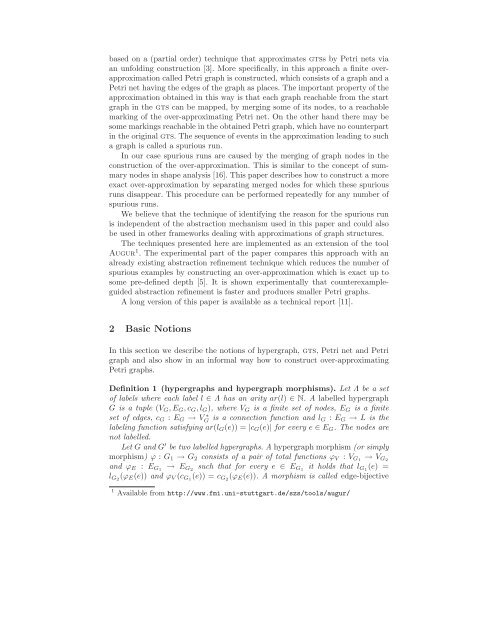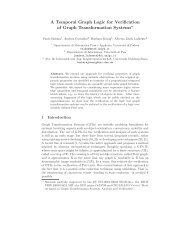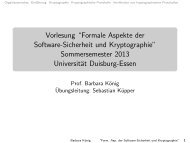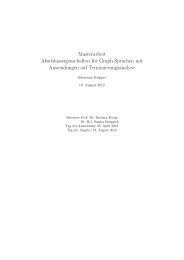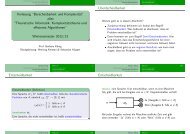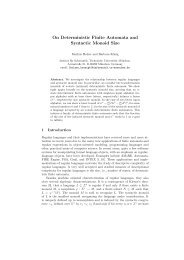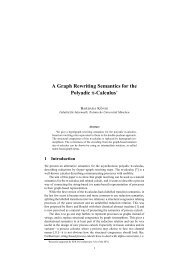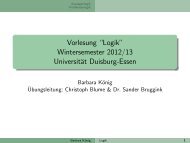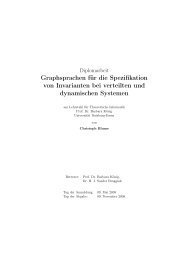Counterexample-guided Abstraction Refinement for the Analysis of ...
Counterexample-guided Abstraction Refinement for the Analysis of ...
Counterexample-guided Abstraction Refinement for the Analysis of ...
You also want an ePaper? Increase the reach of your titles
YUMPU automatically turns print PDFs into web optimized ePapers that Google loves.
ased on a (partial order) technique that approximates gtss by Petri nets viaan unfolding construction [3]. More specifically, in this approach a finite overapproximationcalled Petri graph is constructed, which consists <strong>of</strong> a graph and aPetri net having <strong>the</strong> edges <strong>of</strong> <strong>the</strong> graph as places. The important property <strong>of</strong> <strong>the</strong>approximation obtained in this way is that each graph reachable from <strong>the</strong> startgraph in <strong>the</strong> gts can be mapped, by merging some <strong>of</strong> its nodes, to a reachablemarking <strong>of</strong> <strong>the</strong> over-approximating Petri net. On <strong>the</strong> o<strong>the</strong>r hand <strong>the</strong>re may besome markings reachable in <strong>the</strong> obtained Petri graph, which have no counterpartin <strong>the</strong> original gts. The sequence <strong>of</strong> events in <strong>the</strong> approximation leading to sucha graph is called a spurious run.In our case spurious runs are caused by <strong>the</strong> merging <strong>of</strong> graph nodes in <strong>the</strong>construction <strong>of</strong> <strong>the</strong> over-approximation. This is similar to <strong>the</strong> concept <strong>of</strong> summarynodes in shape analysis [16]. This paper describes how to construct a moreexact over-approximation by separating merged nodes <strong>for</strong> which <strong>the</strong>se spuriousruns disappear. This procedure can be per<strong>for</strong>med repeatedly <strong>for</strong> any number <strong>of</strong>spurious runs.We believe that <strong>the</strong> technique <strong>of</strong> identifying <strong>the</strong> reason <strong>for</strong> <strong>the</strong> spurious runis independent <strong>of</strong> <strong>the</strong> abstraction mechanism used in this paper and could alsobe used in o<strong>the</strong>r frameworks dealing with approximations <strong>of</strong> graph structures.The techniques presented here are implemented as an extension <strong>of</strong> <strong>the</strong> toolAugur 1 . The experimental part <strong>of</strong> <strong>the</strong> paper compares this approach with analready existing abstraction refinement technique which reduces <strong>the</strong> number <strong>of</strong>spurious examples by constructing an over-approximation which is exact up tosome pre-defined depth [5]. It is shown experimentally that counterexample<strong>guided</strong>abstraction refinement is faster and produces smaller Petri graphs.A long version <strong>of</strong> this paper is available as a technical report [11].2 Basic NotionsIn this section we describe <strong>the</strong> notions <strong>of</strong> hypergraph, gts, Petri net and Petrigraph and also show in an in<strong>for</strong>mal way how to construct over-approximatingPetri graphs.Definition 1 (hypergraphs and hypergraph morphisms). Let Λ be a set<strong>of</strong> labels where each label l ∈ Λ has an arity ar(l) ∈ N. A labelled hypergraphG is a tuple (V G ,E G ,c G ,l G ), where V G is a finite set <strong>of</strong> nodes, E G is a finiteset <strong>of</strong> edges, c G : E G → V ∗ G is a connection function and l G : E G → L is <strong>the</strong>labeling function satisfying ar(l G (e)) = |c G (e)| <strong>for</strong> every e ∈ E G . The nodes arenot labelled.Let G and G ′ be two labelled hypergraphs. A hypergraph morphism (or simplymorphism) ϕ : G 1 → G 2 consists <strong>of</strong> a pair <strong>of</strong> total functions ϕ V : V G1 → V G2and ϕ E : E G1 → E G2 such that <strong>for</strong> every e ∈ E G1 it holds that l G1 (e) =l G2 (ϕ E (e)) and ϕ V (c G1 (e)) = c G2 (ϕ E (e)). A morphism is called edge-bijective1 Available from http://www.fmi.uni-stuttgart.de/szs/tools/augur/


